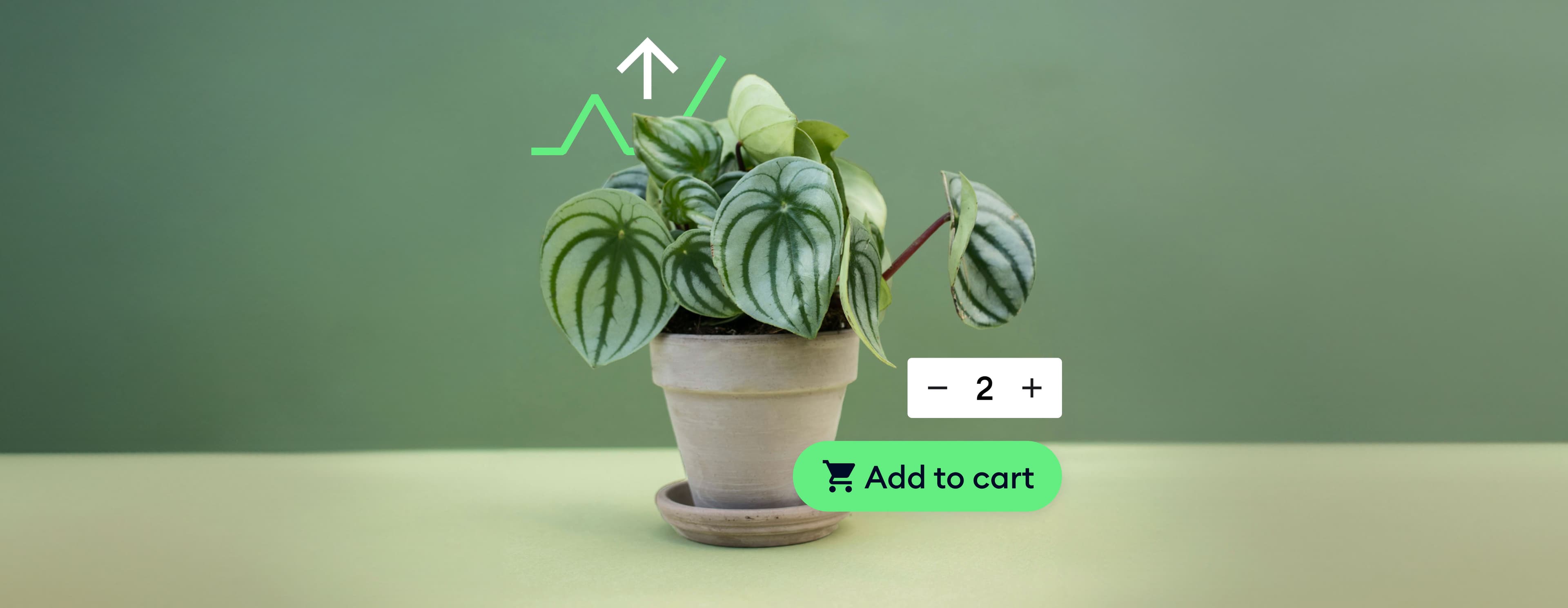As a Shopify store owner, you’re doing the work—your site looks great, your products are top-notch, and you’ve even driven some traffic to your store.
But there’s a problem.
Despite all your efforts, the sales just aren’t coming in like you expected. The truth is, having a well-designed store and traffic is only half the battle. The real challenge lies in converting those visitors into paying customers.
And that’s exactly where Shopify conversion rate optimization (CRO) comes into play.
In this article, we’ll uncover the most effective strategies for increasing your conversion rates.
Optimize your conversion rates using Shopify chatbots
How to increase conversion rate on Shopify
Here are the top 15 strategies for your CRO Shopify:
1. Optimize product pages
Since customers can’t physically visit your shop, high-resolution images are essential. Along with quality product photos, consider adding 360-degree views, demo videos, or 3D visualizations.
On top of that, use short, clear product descriptions that highlight key features and benefits. It’s not just what you say, but how you say it—your brand voice plays a big role in building trust and boosting conversions.
Some ways to optimize your product pages include:
- Social proofing—display product ratings on your pages to build trust in your brand
- A clear return policy—provide it to give confidence to customers that they can return the product if it’s not the right fit for them
- Videos demos—create captivating demonstration videos showcasing your product working on their own
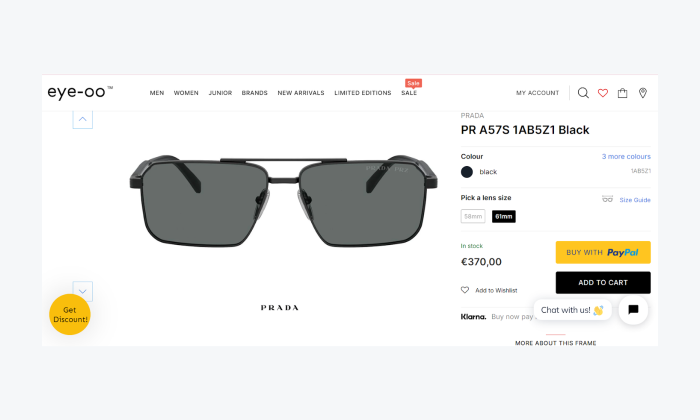
Eye-oo, is an eyewear retail company running a multi-approach conversion strategy. The images are stylish and visually appealing. You can click on the tiled thumbnail appearing on the left side of the product to see 360°view angles. Also, if you have any pressing inquiry, you can open up the chat box on the lower right of the page and engage with a live agent.
2. Streamline the checkout process
A complicated checkout process can frustrate customers and lead to abandoned carts, costing you sales. That’s why it’s essential to simplify each step of the purchase.
Make it easy by reducing the number of form fields, offering multiple payment options, and clearly displaying shipping and tax information upfront. If possible, implement a one-click checkout—it speeds up transactions and cuts down on cart abandonment by removing unnecessary hassle. The smoother the experience, the more likely customers are to complete their purchase.
In a one-click checkout process, you can:
- Personalize the checkout to match your website
- Select payment options (credit card, money transfer)
- Implement loyalty programs, coupons, and customer accounts
- Autofill customer information for speedy checkouts
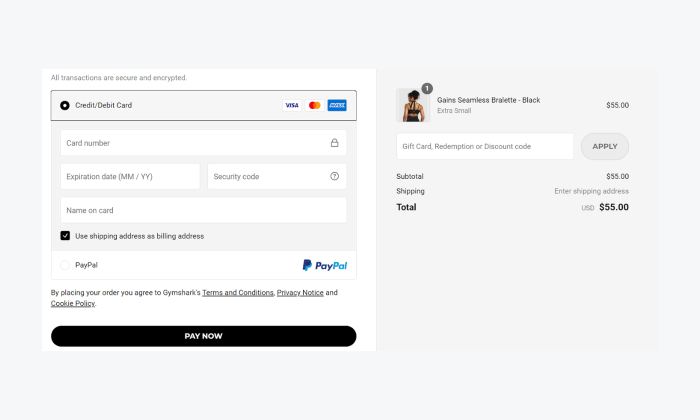
A real use case is Gymshark, a gym and workout clothing store. The checkout process is simple and straightforward. On the checkout page, the selected items with the cost summaries are displayed on the right while the payment details are on the left. This makes it easy to counter-check before the final desired action.
Read more: Discover how Interatec boosted its qualified lead generation by 25% with Tidio
3. Use abandoned cart recovery
Abandoned carts are expected in both physical and digital stores. In fact, Baymard Institute reports that 70% of online shoppers abandon their carts. This translates to seven out of every ten of your shoppers leaving before completing the purchase.
But an abandoned cart should not be written off as a lost sale but rather as a chance to engage the customer, build a relationship, and see if you can change their mind. This Shopify conversion optimization uses email marketing campaigns, SMS, retargeting, and automation to effectively turn it around for your business.
Here are a few tactics you can use:
- Automated emailing—set up a set of remarketing emails that will remind the customers of the items left in their cart and use abandoned cart flows to automate the process
- Exclusive offers—incentivize re-engagement by throwing in enticing perks like discounts or free shipping
- SMS reminders—send text messages to customers if you have their number as this is an effective medium of communication given its high open rate
- Exit-intent pop-ups—shoot a pop-up window to visitors reminding them of the items left in the cart before they exit
- Free returns—customers feel more assured if you offer free returns, so it’s a good way to reduce the purchase risk, build trust, and increase confidence in the product’s value
- A range of delivery options – Up to 56% of abandoned carts are due to limited delivery options. Ensuring you offer a selection of delivery types to suit each of your customers makes their experience as convenient as possible
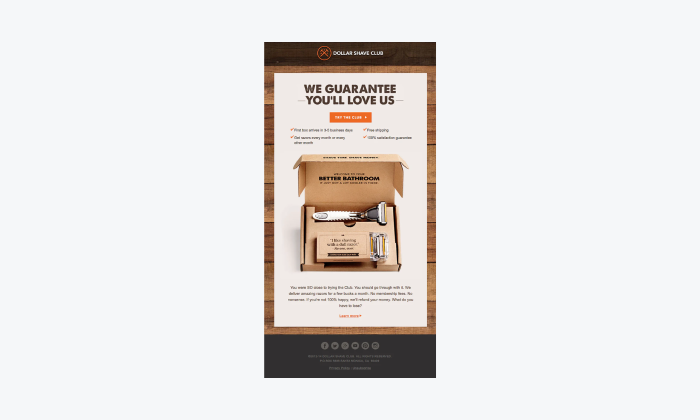
This is a reminder cart abandonment email from Dollar Shave Club, a men’s grooming online store. Its brand is known for witty and personalized email messaging starting with the subject line, “Where did you go?”. When opened, the short and concise bullet points convey the message home. Not to mention, the money-back guarantee clarifies any doubt customers may have.
Read more: Check out the best Shopify cart abandonment software with pros, cons, and pricing compared.
4. Enhance site speed
Slow-loading websites, particularly those that take three seconds or more to load, can significantly increase your site’s bounce rate. That’s because impatient customers will leave your site before the pages fully load, leading to lost sales opportunities. This lag also negatively impacts your on-site and off-site SEO efforts, as search engines favor fast-loading sites, meaning a slow website can go down in rankings, making your store harder to find for new customers.
To combat these issues, enhancing your site’s speed is crucial. You can do it by optimizing images, using responsive design, enabling browser caching, and possibly investing in a content delivery network (CDN) to reduce server load times.
Here are some of the applicable fixes:
- Moving render-blocking resources to cdn.shopify.com
- Modifying the navigation bar CSS
- Reserving space for the gallery elements on the product page
- Enable browser caching
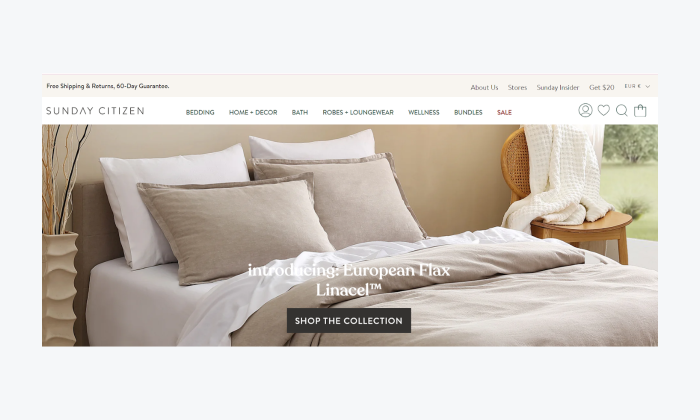
An example of this tactic used in real life is Sunday Citizen. This luxury manufacturer recorded a 6% improvement in conversion and a 4% reduction in bounce rate after shifting to Shopify after implementing several rendering improvements.
5. Improve mobile usability
As mobile shopping continues to surge, optimizing the mobile experience is crucial for boosting conversion rates on your Shopify store. With around 70% of mobile users relying on their phones to research or purchase products, a seamless mobile experience can make or break a sale.
To capitalize on this trend, ensure your site is responsive, with easy navigation, quick load times, and a streamlined checkout process tailored for mobile devices. Incorporating specific features like a buy now button, wallets, and autofill options makes it easier for customers to complete purchases on the go. In today’s mobile-first world, a well-optimized mobile experience is essential for driving sales and staying competitive.
You can implement this by:
- Making sure your theme design is responsive
- Having fast loading times
- Running simple navigation
- Using a touch-friendly design
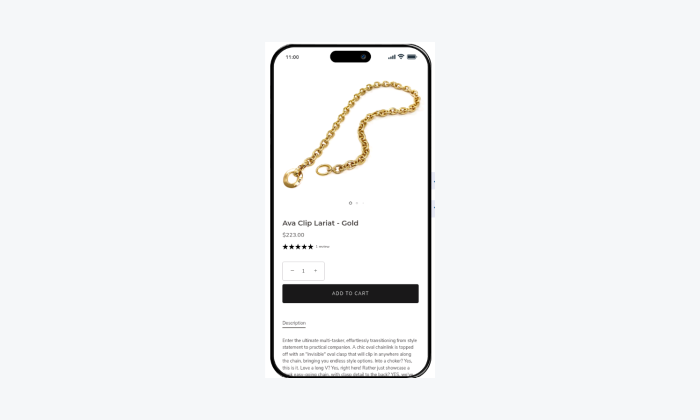
Biko, a jewelry store built on Shopify, has a visually appealing display on mobile phones. All high-priority content is captured from forms, discount codes, sale items, and call-to-action buttons. Meanwhile, all the other desktop elements, like bolding and appropriate heading, still apply. On top of that, the brand made the CTAs larger to draw attention and incentivize the visitor to make a click.
Read more: Learn the useful mobile commerce statistics to boost your store’s conversions.
6. Leverage live chat and chatbots
Using live chat software with integrated chatbots on your Shopify store is a powerful strategy for boosting ecommerce conversion rates. Live chat enables real-time, personalized communication, allowing your team to address inquiries instantly, which can significantly increase customer satisfaction.
Meanwhile, AI chatbots ensure your store is always accessible, providing 24/7 support and guiding visitors through common issues or questions, even when your team is offline.
This combination of human and automated assistance enhances the shopper’s experience and streamlines the sales processes. And, in the long run, it can lead to higher conversion rates and improved customer loyalty.
You can implement live chat and chatbots by:
- Choosing a suitable platform
- Creating an easy-to-adopt chatbot
- Training your chatbot thoroughly
- Regularly updating the bot’s knowledge base
- Integrating the chatbot with your marketing tools
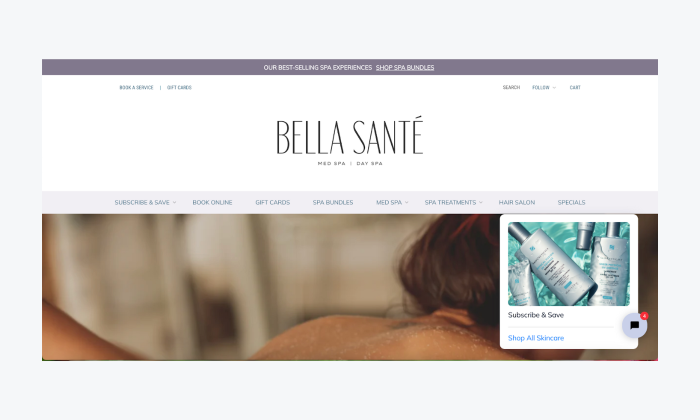
Bella Sante, for example, uses chatbots to increase conversion rates of its Shopify website. In fact, boosted sales by over $66K and increased lead generation since implementing conversational AI.
Read more: Learn how to install Tidio on your Shopify store in a few easy steps.
Boost your conversions using AI chatbots
7. Offer personalized recommendations
Personalized product recommendations can significantly boost Shopify conversions. By tracking browsing behavior, purchase history, and return visitor patterns, you can show products that match each shopper’s interests. Tools like Google Analytics, Hotjar, or advanced CRM systems help with this.
And personalization not only improves the customer experience but also increases upselling and cross-selling opportunities, raising your average order value. In fact, product recommendations drive 31% of ecommerce revenues, proving their power to turn browsers into loyal customers.
You can implement personalized recommendations on your website by:
- Collecting and analyzing customer data including purchase history, preferences and behaviors
- Leveraging machine learning algorithms and conversational AI
- Optimizing engagement by segmenting your target audience
- Tracking customer journey on your website and app including pages visited, time spent on pages, and products viewed
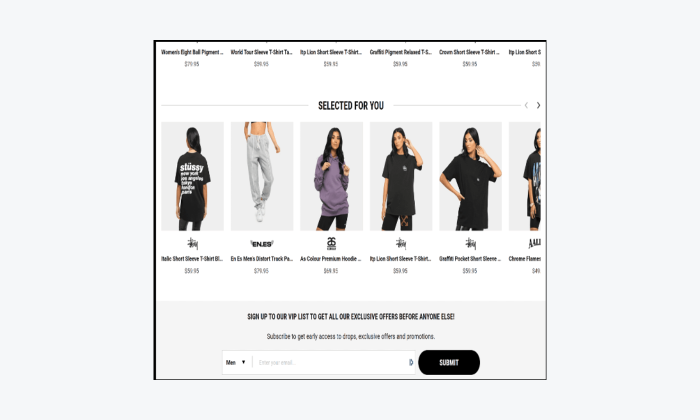
An example is the Australian street brand Culture King offering personalized recommendations in the form of Selected for you section. Based on the initial product you are interested in, algorithms find similar alternatives and recommend them below the product description.
8. Implement scarcity and urgency tactics
Scarcity and urgency tactics play on FOMO (fear of missing out), making customers more likely to act fast when they think a product is limited or time-sensitive.
Use countdown timers, low-stock alerts, or limited-time offers on your product pages to create urgency. These strategies boost perceived value and prompt quicker decisions, reducing cart abandonment.
Smart examples of urgency tactics that elicit FOMO are:
- Flash sales
- Countdown timers on product pages
- Limited offers
- Exclusive product drops
- Add to cart reservations
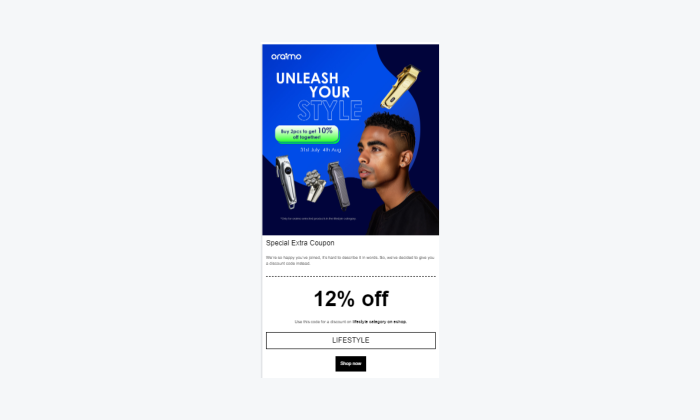
For example, Oraimo, a smart electronics brand, sends out occasional flash sales with a discount. This email goes out to the brand’s subscribers, giving visitors an additional reason to sign up to the company’s mailing list.
9. Optimize for SEO (Search Engine Optimization)
Investing in SEO boosts your website’s search rankings, helping your store show up on the first page of Google for relevant keywords. This increases visibility and drives more organic traffic from people actively searching for products like yours.
With more targeted traffic, your chances of turning visitors into paying customers rise. Plus, an SEO-optimized site usually delivers a better user experience with faster load times, clear navigation, and relevant content—leading to higher conversion rates.
Here are some approaches to go about this:
- Keyword research—generate relevant keywords through SEO software which runs an audit of your web pages and suggests top-ranking keywords
- Blog content—produce high-quality content in the form of blog posts and ensure the content is original, highly informative, keyword-optimized, and useful to a reader
- Structure—structure your pages for the best user experience possible and update your content so it remains relevant
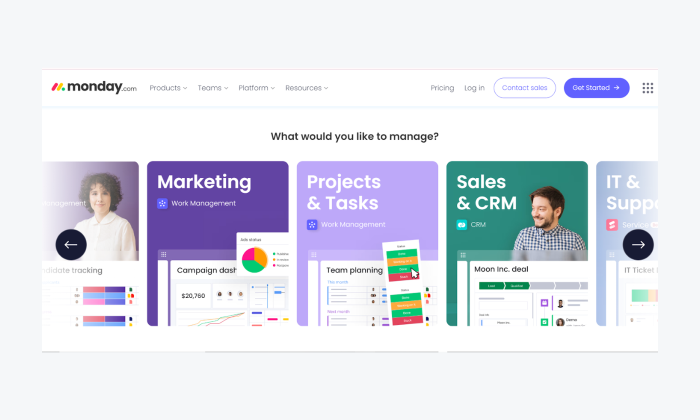
Monday.com is a good example of a website optimized for the Search Engines. It runs paid and organic ways to market and acquire customers. The keyword research strategy here deploys content briefs that ensure it remains on the first page of search engine rankings.
10. Offer clear return and shipping policies
Clear return and shipping policies boost your reputation and customer loyalty. A strong return policy gives shoppers confidence, while free shipping attracts potential buyers. Well-written policies reduce lost sales and strengthen your brand.
Shopify order management is a smart way of monitoring and optimizing your return process. And returns management software helps customers initiate returns, receive pre-paid labels, and ship back the products in a timely manner. This system further helps to manage and track your returns by relisting items approved back to your inventory while managing the financial impacts of those returns.
Shopify return policy comprise of:
- Customer self-service return process—return policy can be accessible on either the FAQ page, website banner or footer, order notification emails, or live chat
- Automated notifications—customers are notified throughout the returns process
- Return shipping labels—automatic emails with labels for Shopify shipping
- Customer refunds—once the item is returned, customers get refunded their original payment via their original payment method by clicking a button
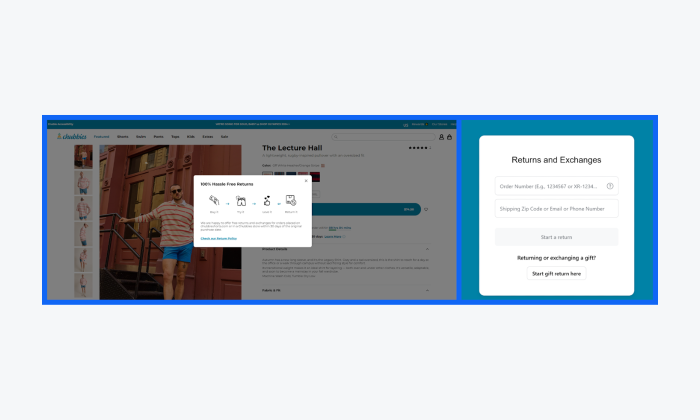
A good example is Chubbies, a men’s clothing brand offering free returns for orders placed on its website. The return is applicable within 30 days of the date of your original purchase.
Read more: Learn how to write an effective ecommerce return policy with examples and templates.
11. Run A/B testing
A/B testing is an essential tool for optimizing Shopify conversion rates by allowing you to identify which elements of your site perform best with your audience. This tactic works by creating two versions of a webpage element, such as banners, buttons, or email subject lines, and displaying each version to 50% of your visitors.
This data-driven approach helps you understand which version drives more engagement, leads to higher sales, or reduces cart abandonment. Over time, A/B testing enables you to make informed decisions about design and content changes to continuously improve your site’s effectiveness and user experience.
You can implement the strategy with these steps:
- Ensure differences between control and variants are targeted
- Experiment with header copy, videos, button placements, images, etc.
- Test headlines, images, product images, layouts, and call-to-action buttons
- Use Shopify apps like Optimizely and Google Optimize for analysis
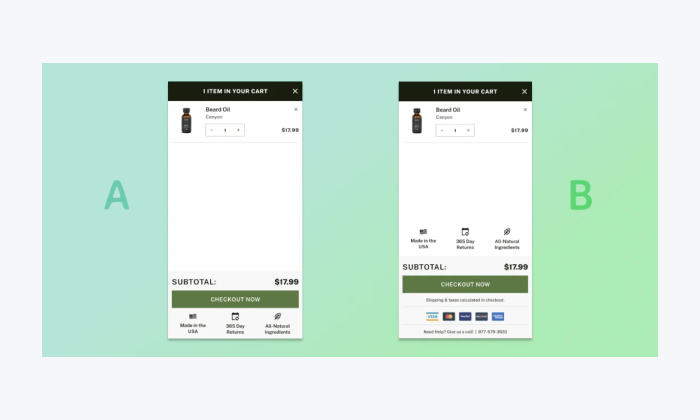
Fuel Made, an ecommerce store ran two A/B test variants while seeking to increase their conversion rates for certain products. The test was done on the website design of the slide out shopping cart where they noticed an 18% increase in conversions by simply showcasing iconography and other information aimed at building trust.
12. Create a sense of community
Boost Shopify conversion rates by using interactive elements like games, activities, and loyalty programs. These features make your brand more memorable and encourage repeat visits.
Building a sense of community fosters emotional connections, leading to increased trust, loyalty, and higher conversion rates. Engaged customers are also more likely to recommend your brand to others, further driving growth.
Some of the strategies used by ecommerce businesses to boost their Shopify conversion rates are:
- Using customer reviews and testimonials—display reviews on your product pages to provide social proof
- Running loyalty programs—you can reward and incentivize repeat customers to make more purchases
- Event and webinars—run online webinars, events, and live streams to share valuable information, showcase new products or create a sense of belonging
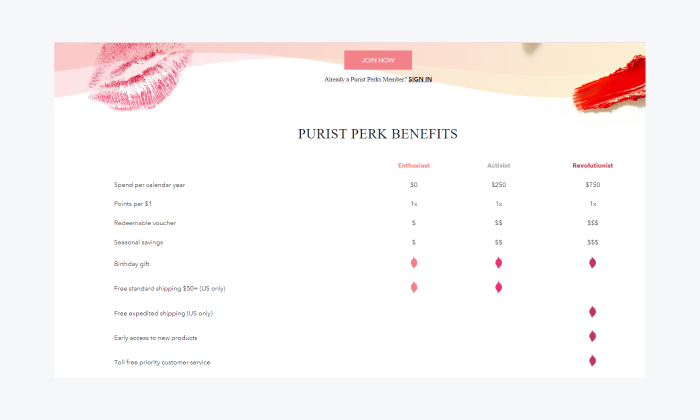
A company called 100% Pure is a great example of this tactic. This skincare beauty brand offers a rewarding system where customers earn points while engaging each other on social media channels or writing reviews/testimonials. This shows the customer that the brand cares about their feelings about the products and services.
13. Utilize high-converting landing pages
Landing pages act as dedicated entry points designed to capture and engage visitors coming from marketing campaigns or paid traffic sources. Unlike home pages, which serve as general gateways to your site, landing pages are specifically tailored to align with the goals of individual campaigns. These could be driving product purchases, encouraging newsletter sign-ups, or promoting special offers.
By focusing on a single, clear call-to-action and eliminating unnecessary distractions, you can maximize the likelihood of visitors taking the desired action. This targeted approach enhances user experience and improves your Shopify conversion rates by ensuring that every element on the page is optimized to drive engagement and sales. Moreover, an effective landing page design can lead to better campaign performance, increased ROI, and a more efficient use of your marketing budget.
The best-optimized landing pages:
- Have user-centered designs
- Use feature-oriented headlines
- Leverage clear and relevant high-quality content
- Have one main call-to-action (CTA) button
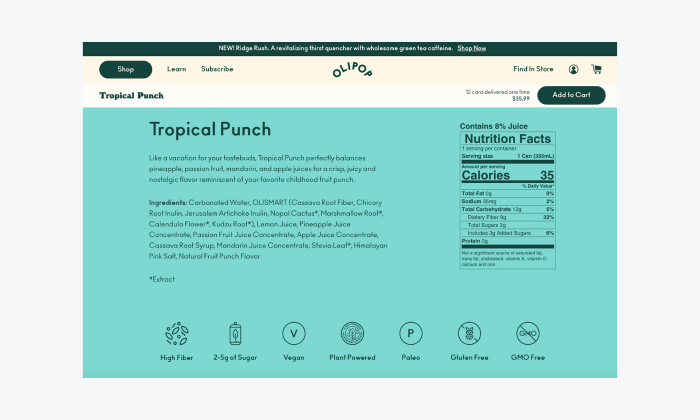
Olipop sells healthy sodas with plant-based ingredients and prebiotics. The brand relies on copies that directly handle objections. In this landing page, the value proposition is creatively displayed in the footer. It emphasizes the product’s 100% vegetarian status and non-testing on animals.
14. Leverage social proof
Social proof is a potent psychological trigger that capitalizes on consumers’ inherent desire to follow the crowd and make informed purchasing decisions. By strategically implementing social proof elements such as customer ratings and reviews, as well as testimonials and user-generated content, you can significantly boost their conversion rates.
These build trust and credibility, reassuring potential buyers that the product is tried, tested, and loved by others. For instance, displaying real-time purchase notifications or showcasing the number of items sold can create urgency and validate the product’s popularity. Moreover, integrating social media feeds or featuring influencer endorsements can further amplify the perceived value and desirability of the products.
So, how to get more conversions on Shopify using this tactic? Here are a few tips:
- Influencer endorsements—if your product has been used by top influencers or mentioned in leading publications, showcase the shout-outs or citations on the site
- Positive reviews—add good customer reviews, ratings, and testimonial videos on your product pages
- Certifications and trust badges—display trust badges, certifications, and awards on your website
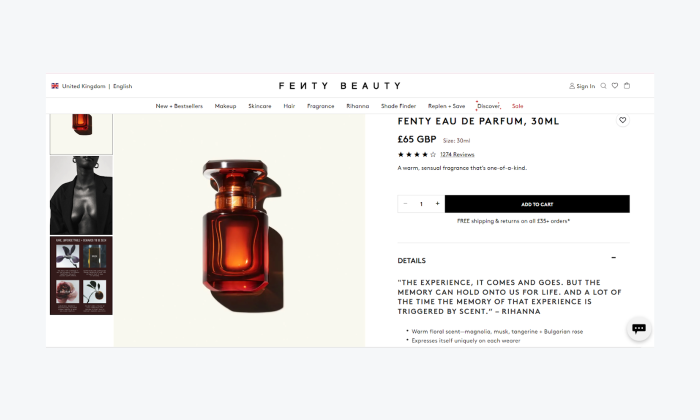
You can spot several quotes by Rihanna on Fenty Beauty’s website. Her public use and strong endorsement of the product is a strong conversation rate optimization tactic.
Did you know that…
Displaying reviews increases a product’s chances of conversion by 270%
15. Simplify site navigation
Developing an intuitive web navigation system is crucial for enhancing user experience and boosting conversion rates on Shopify stores. A well-designed navigation structure enables visitors to find what they’re looking for effortlessly, reducing frustration and minimizing bounce rates.
Key elements of effective navigation include an enhanced search bar with autocomplete functionality, a logically organized menu, consistent navigation across all pages, and breadcrumb filters. These ensure the items are well categorized and the navigation is easy to use, allowing users to quickly locate specific products or refine their search easily.
Effective ways of implementation are:
- Simplify and minimize your menu options by focusing on essentials
- Structure menu in a clear and intuitive manner with a logical hierarchy and descriptive labels
- Ensure the navigation across the site is uniform and consistent
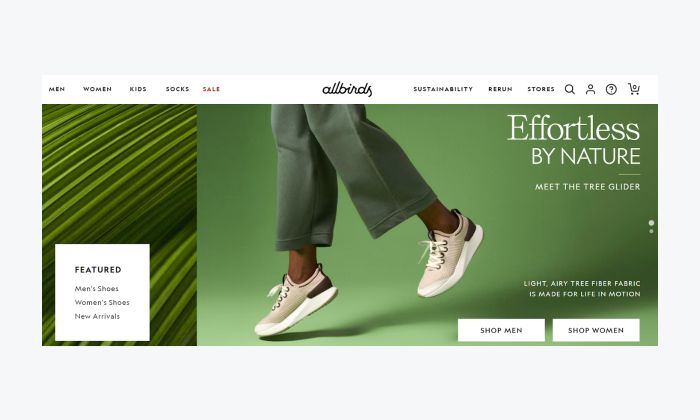
Allirds, an online shoe brand, has trimmed its site navigation to only showcase the most relevant and essential categories like “Women,” “Men,” and “New Arrivals.” This makes it very simple for visitors to find what they need.
Now that we have gone through some of the top CRO strategies, let’s check out the top tools.
Read more: Learn how to launch an ecommerce store with this checklist.
Top CRO tools for Shopify
Conversion rate optimization (CRO) platforms resolve friction encountered by decision-makers by presenting data-driven recommendations that boost conversions. An analysis of user behavior on areas like areas of clicks, customer interactions, and other site navigation options such as heat maps or A/B testing.
Here are the CRO tools that best align with your business goals:
- Tidio Live Chat & Chatbots—enhances customer support and engagement by delivering automated responses and real-time assistance.
- Avada SEO Speed Image Optimize—page speed optimization, SEO audit, on-page SEO optimization, and reporting.
- Visually | A/B Testing & CRO—personalized behavioral targeting, shipping & guest checkout, and full-funnel tests with no code required.
- BOOSTER SEO & image optimizer—auto-identification and fixing on SEO site issues, SEO score booster, and meta tags optimizer.
- Pop Convert ‑ Pop Ups, Banners—comprehensive smart bar, leads pop-up, customizable smart bars, and drag and drop editor.
Shopify conversion rate optimization: key takeaways
For most brands today, their website content delivers the sales pitch and the goal is to get visitors clicking on the call to action. So, to compete effectively, businesses need content that is engaging, informative and communicates what prospects need.
The top Shopify CRO strategies include:
- Optimize Shopify product pages
- Streamline the checkout process
- Use abandoned cart recovery
- Enhance site speed
- Improve mobile usability
- Leverage live chat and chatbots
- Offer personalized recommendations
- Implement scarcity and urgency tactics
- Optimize for Search Engines
- Offer clear return and shipping policies
- Run A/B testing on your site
- Create a sense of community
- Utilize high-converting landing pages
- Leverage social proof
- Simplify site navigation
And why not start optimizing your online store right away?
Improve your conversions using AI chatbots
Frequently Asked Questions
To calculate your conversion rate, you should divide the total number of conversions by the number of visitors then multiply it by 100.
A good Shopify conversion rate is 3.3% or more. It varies depending on your industry and specific goals.
You can improve Shopify conversion rate by optimizing your website speed, simplifying navigation, adopting high-quality images, and providing effective customer support. You can also use tools for optimizing your website for search engines, communicating with clients in real time, and collecting customer data.
Poor customer experience, bad marketing strategies, unclear trust signals, and technical issues can affect conversion rates. Analyzing more customer feedback metrics can help identify problems and address them.
The conversion rate formula in (conversions / visitors) * 100. This calculation gives the percentage of website visitors who complete specific actions.
Among the vital skills required to conduct effective conversion rate optimization are analytical thinking, research and technical skills, UI and UX design, as well as creativity to deliver a solid digital marketing.
